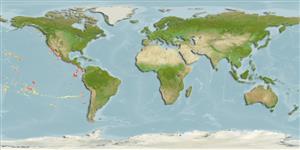Actinopterygii (ray-finned fishes) >
Lophiiformes (Anglerfishes) >
Ogcocephalidae (Batfishes)
Etymology: Dibranchus: Greek, di = two + Greek, brangchia = gills (Ref. 45335).
Environment / Climate / Range
Ecology
Marine; bathydemersal; depth range 700 - 1150 m (Ref. 40826). Deep-water, preferred ?
Eastern Pacific: Galapagos Islands, Cocos Island, and Peninsula de Azuero, Panama.
Size / Weight / Age
Maturity: Lm ? range ? - ? cm
Max length : 11.0 cm SL male/unsexed; (Ref. 40826)
Short description
Morphology | Morphometrics
Dorsal
soft rays
(total): 4-6;
Anal
soft rays: 4. Entire body covered with moderate sized tubercles interspersed with very small tubercles. Cephalic lateral-line counts: subopercular usually 6, (5-7); preopercular, 3 (2-4). Tail lateral-line counts 10-15. Subopercular spines long. Paired fins and caudal with sparse tubercles running out on fin rays a short distance. Fins moderate size, pectoral fins slender, pelvic fins with thickened skin (Ref. 40826). Teeth on vomer and palatines (Ref. 35447).
Life cycle and mating behavior
Maturity | Reproduction | Spawning | Eggs | Fecundity | Larvae
Bradbury, M.G., 1999. A review of the fish genus Dibranchus with descriptions of new species and a new genus, Solocisquama (Lophiiformes, Ogcocephalidae). Proc. Calif. Acad. Sci. 51(5):259-310. (Ref. 40826)
IUCN Red List Status (Ref. 115185)
CITES (Ref. 94142)
Not Evaluated
Threat to humans
Harmless
Human uses
More information
Common namesSynonymsMetabolismPredatorsEcotoxicologyReproductionMaturitySpawningFecundityEggsEgg development
Age/SizeGrowthLength-weightLength-lengthLength-frequenciesMorphometricsMorphologyLarvaeLarval dynamicsRecruitmentAbundance
ReferencesAquacultureAquaculture profileStrainsGeneticsAllele frequenciesHeritabilityDiseasesProcessingMass conversion
Tools
Can't connect to MySQL database fbquizv2. Errorcode: Too many connections
